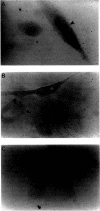Abstract
Previously, we reported two DNA repair-defective siblings who did not belong to any complementation group of xeroderma pigmentosum (XP) or Cockayne syndrome (CS). By surveying other photosensitive patients whose fibroblasts showed similar biochemical phenotypes, we found another nonconsanguineous Japanese patient belonging to the same complementation group as our previous cases. Postreplication repair of the cells derived from these patients was normal, indicating that they cannot be classified as XP variant. Neither transfection nor microinjection of the cells with the human DNA repair gene ERCC1, which is known not to correct any complementation groups of XP or CS, failed to correct the defect of these cells, indicating that they do not belong to the rodent complementation group 1. However, the defect in recovery of RNA synthesis (RRS) after UV irradiation was restored by microinjection of HeLa cell extract. Although clinical manifestations of these patients--such as acute sunburn, dryness, freckling, pigmentation anomalies on sun-exposed skin, and teleangiectasia without neurological abnormalities or tumors--are similar to a mild XP phenotype, cellular characteristics such as UV sensitivity and defective RRS after UV irradiation with normal unscheduled DNA synthesis (UDS) are reminiscent of CS. On the basis of these results, we propose that these patients be included under a general category designated "UV-sensitive" (UVs) syndrome.
Full text
PDF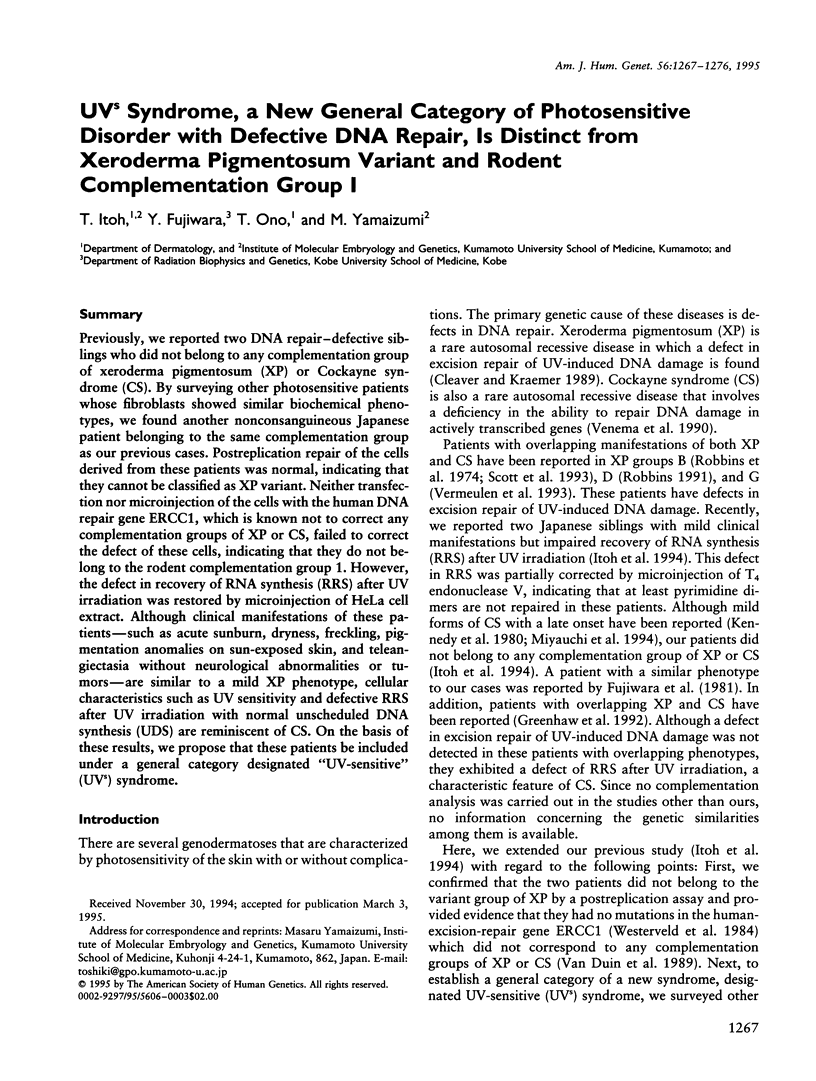
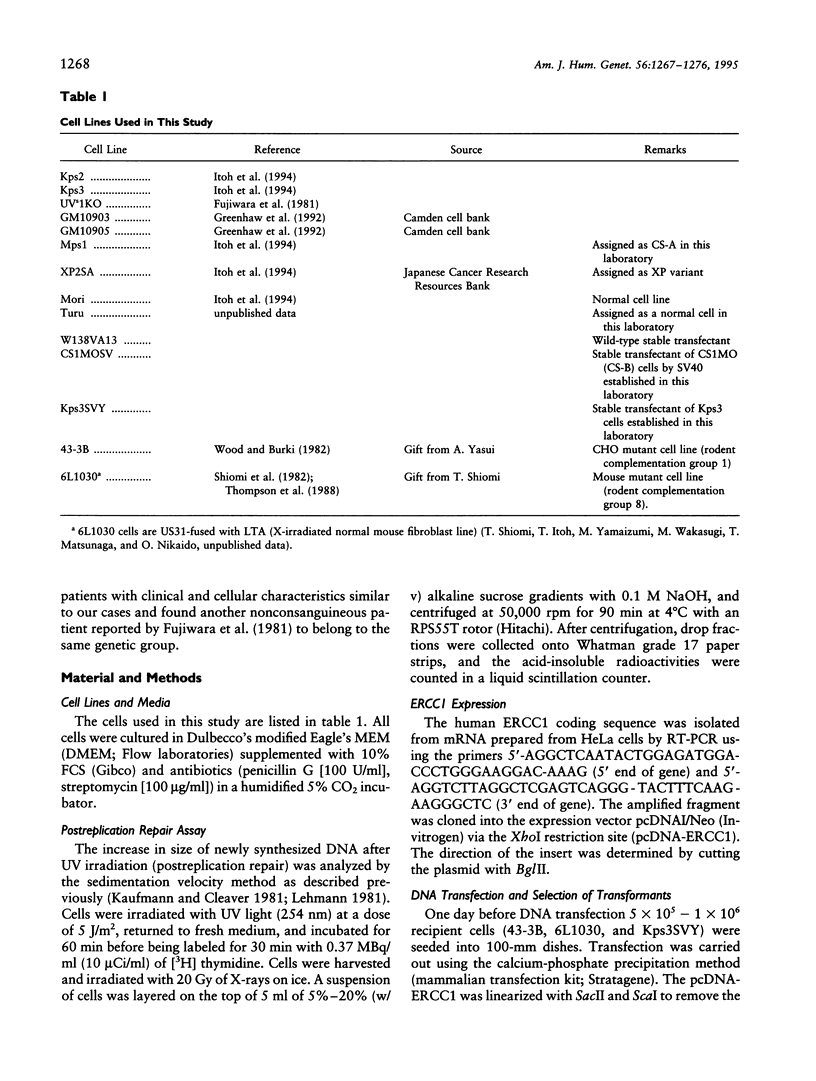
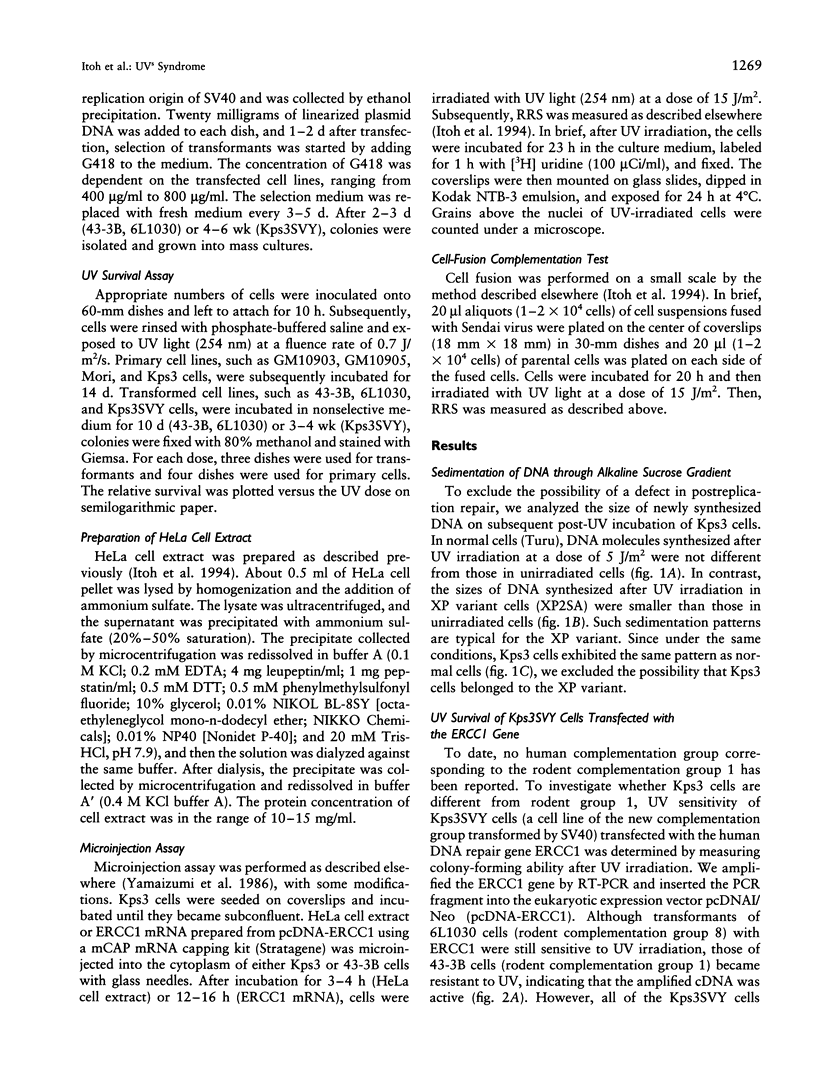
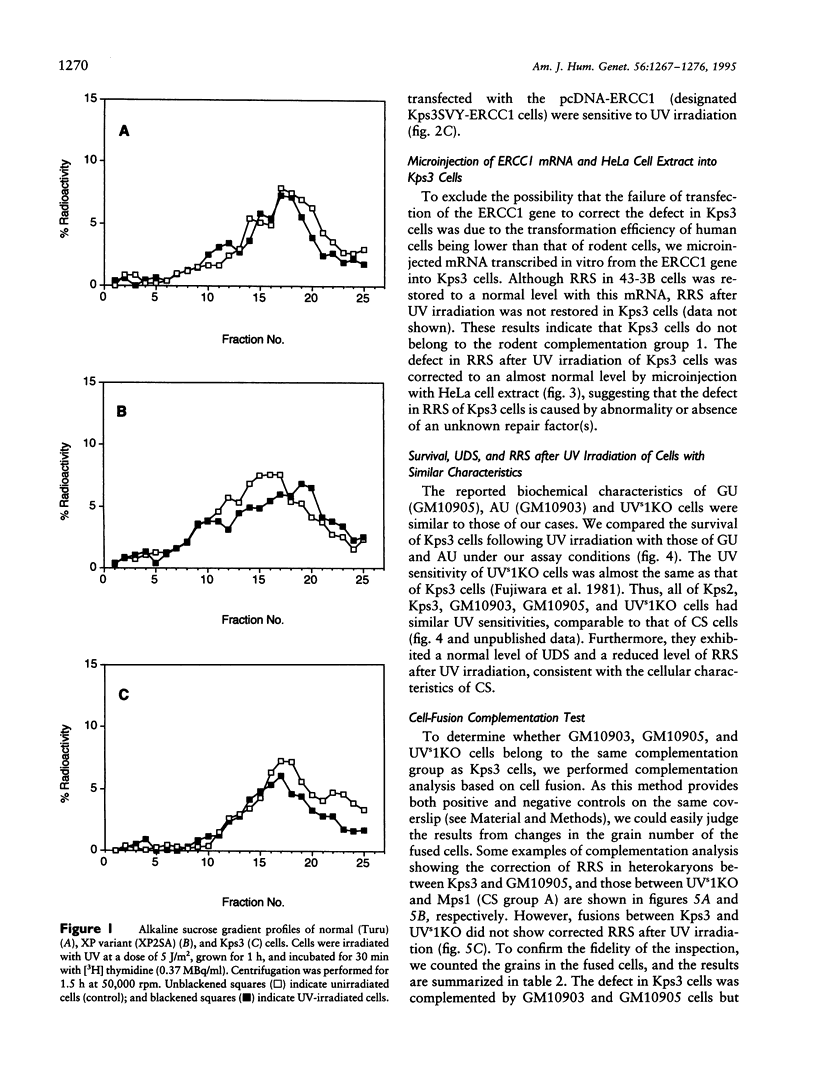
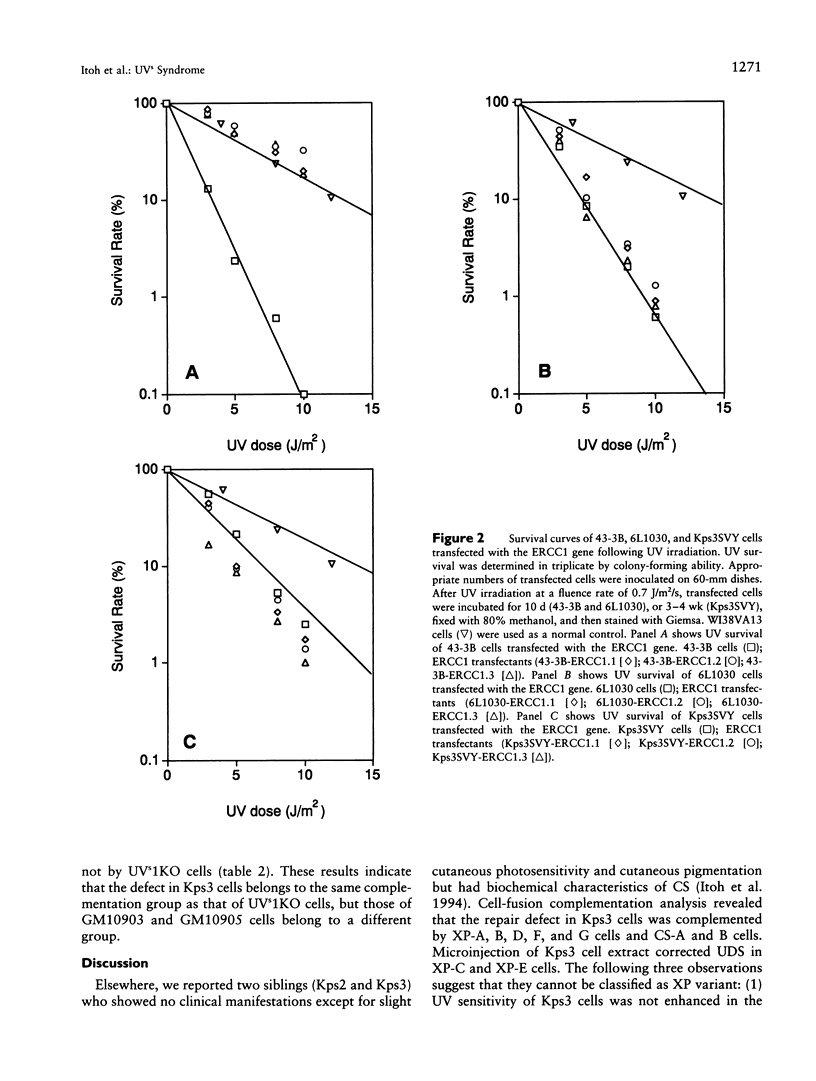
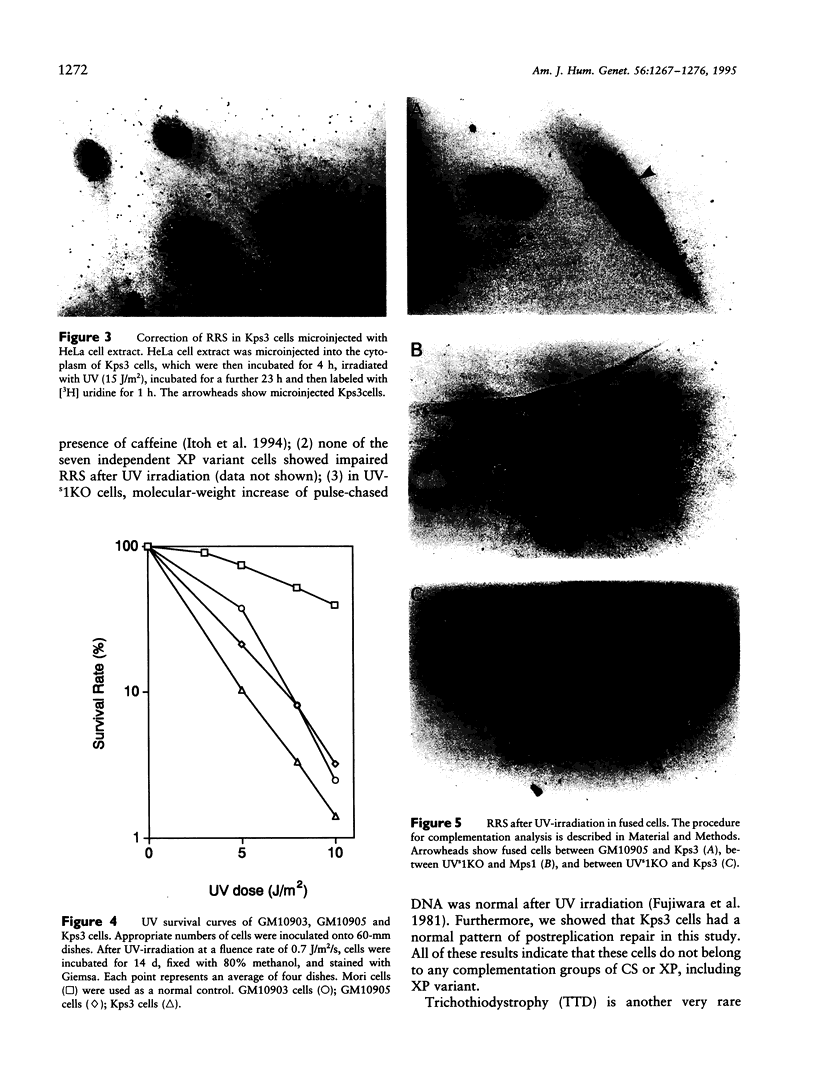
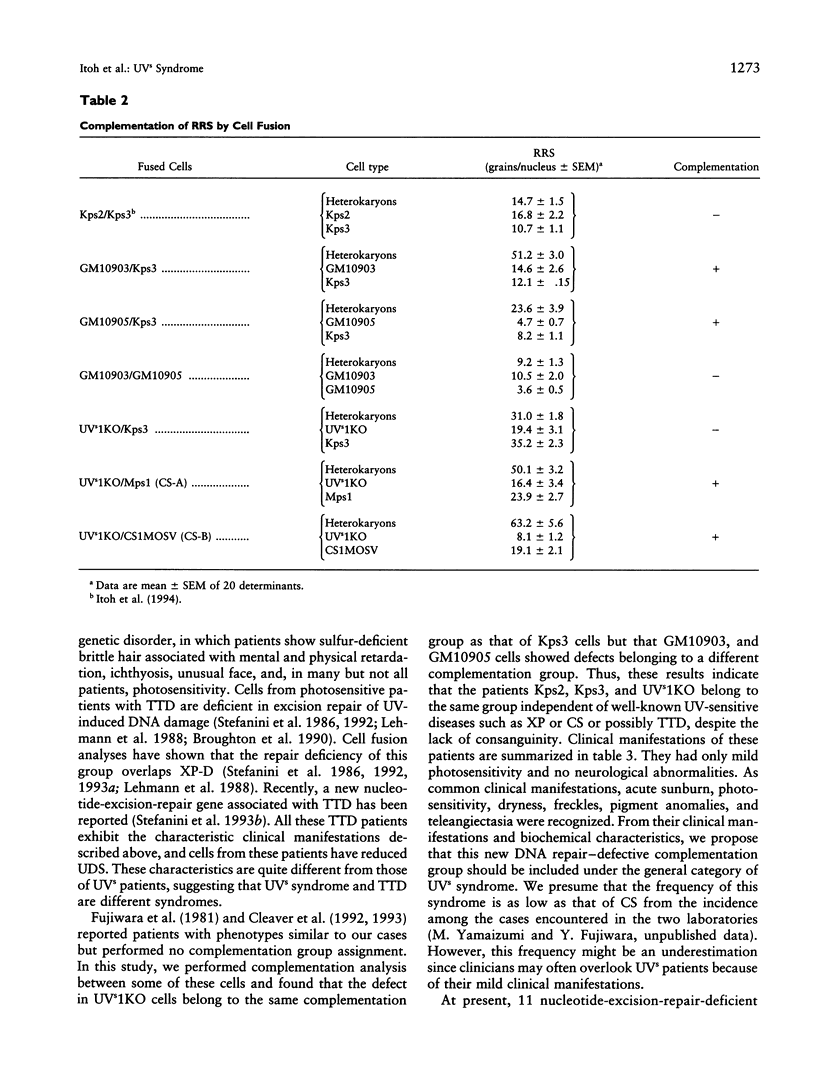
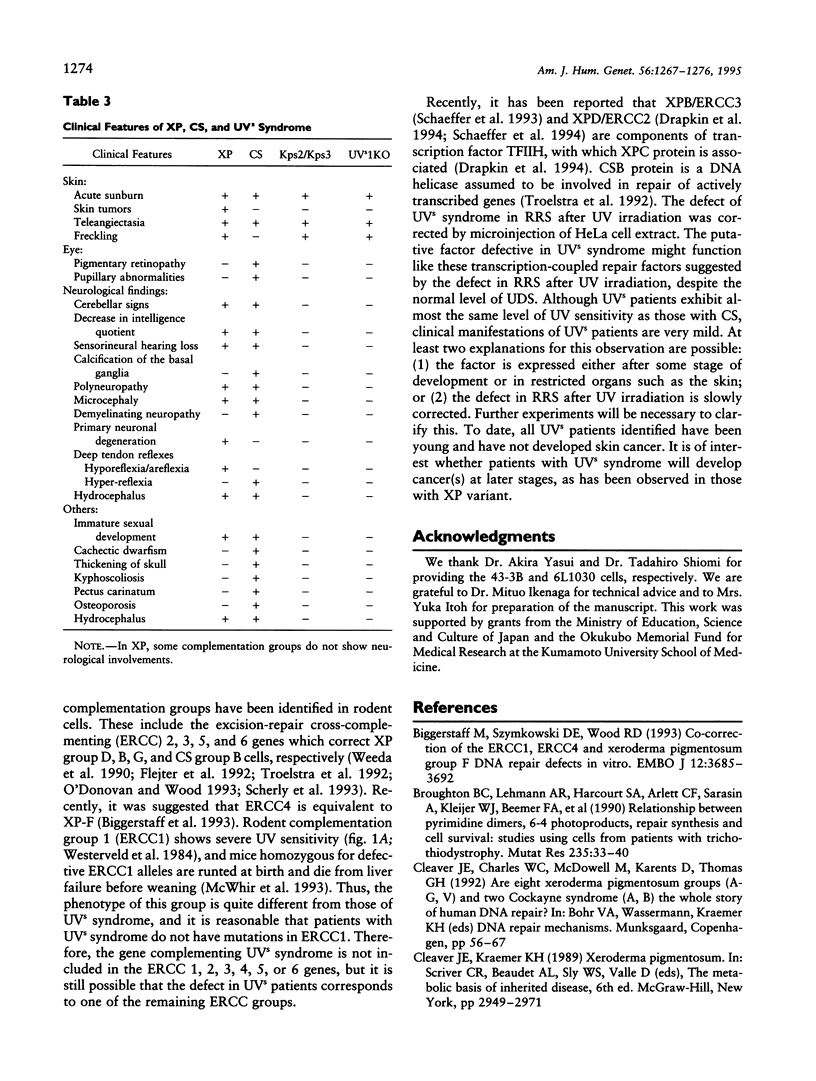
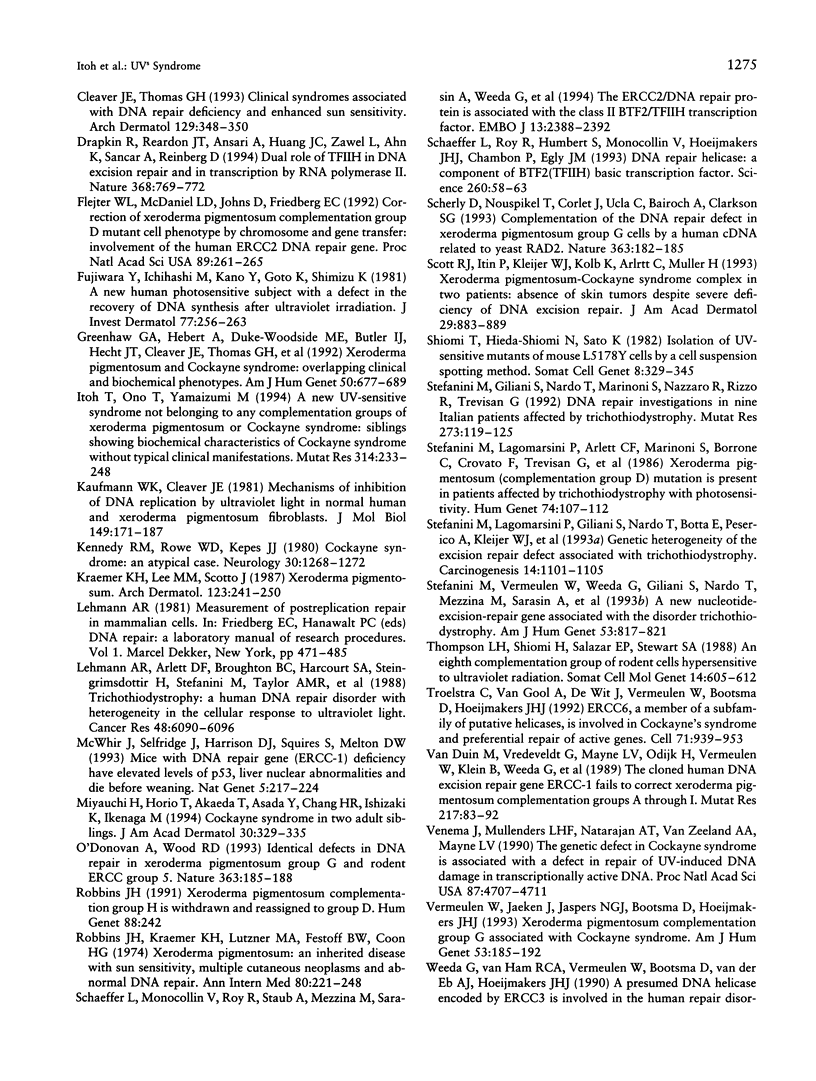
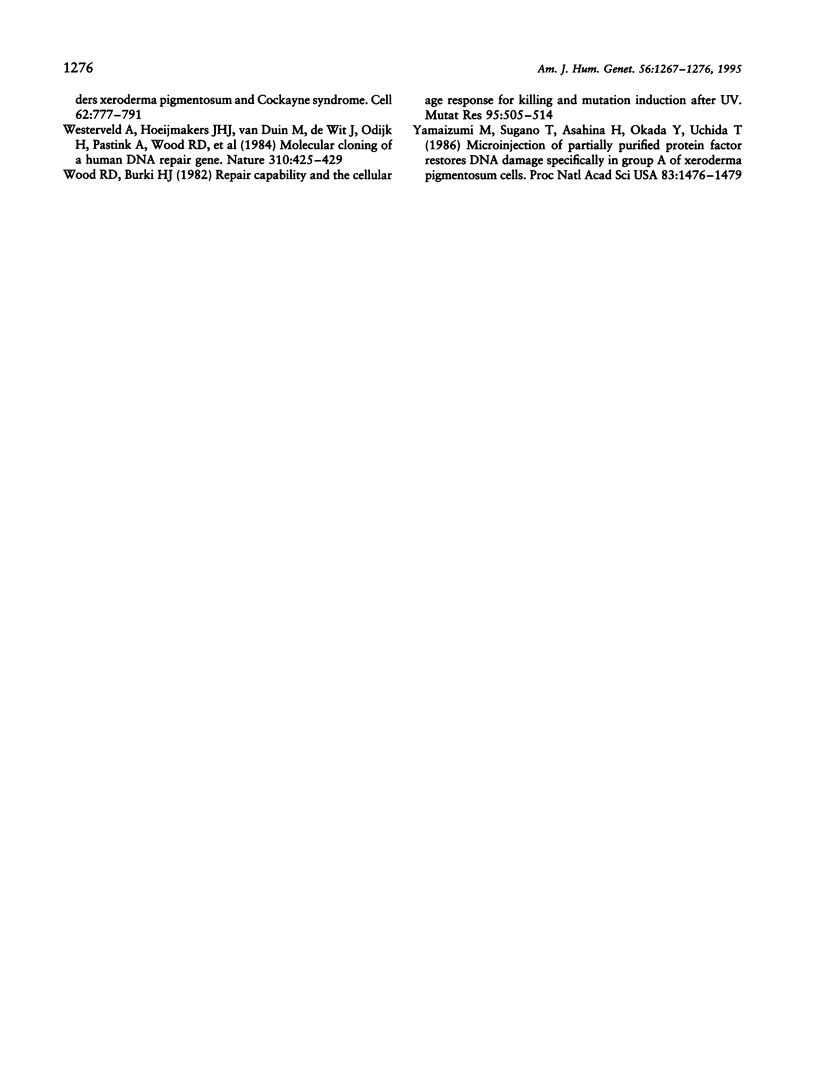
Images in this article
Selected References
These references are in PubMed. This may not be the complete list of references from this article.
- Biggerstaff M., Szymkowski D. E., Wood R. D. Co-correction of the ERCC1, ERCC4 and xeroderma pigmentosum group F DNA repair defects in vitro. EMBO J. 1993 Sep;12(9):3685–3692. doi: 10.1002/j.1460-2075.1993.tb06043.x. [DOI] [PMC free article] [PubMed] [Google Scholar]
- Broughton B. C., Lehmann A. R., Harcourt S. A., Arlett C. F., Sarasin A., Kleijer W. J., Beemer F. A., Nairn R., Mitchell D. L. Relationship between pyrimidine dimers, 6-4 photoproducts, repair synthesis and cell survival: studies using cells from patients with trichothiodystrophy. Mutat Res. 1990 Jan;235(1):33–40. doi: 10.1016/0921-8777(90)90020-6. [DOI] [PubMed] [Google Scholar]
- Cleaver J. E., Thomas G. H. Clinical syndromes associated with DNA repair deficiency and enhanced sun sensitivity. Arch Dermatol. 1993 Mar;129(3):348–350. [PubMed] [Google Scholar]
- Drapkin R., Reardon J. T., Ansari A., Huang J. C., Zawel L., Ahn K., Sancar A., Reinberg D. Dual role of TFIIH in DNA excision repair and in transcription by RNA polymerase II. Nature. 1994 Apr 21;368(6473):769–772. doi: 10.1038/368769a0. [DOI] [PubMed] [Google Scholar]
- Flejter W. L., McDaniel L. D., Johns D., Friedberg E. C., Schultz R. A. Correction of xeroderma pigmentosum complementation group D mutant cell phenotypes by chromosome and gene transfer: involvement of the human ERCC2 DNA repair gene. Proc Natl Acad Sci U S A. 1992 Jan 1;89(1):261–265. doi: 10.1073/pnas.89.1.261. [DOI] [PMC free article] [PubMed] [Google Scholar]
- Fujiwara Y., Ichihashi M., Kano Y., Goto K., Shimizu K. A new human photosensitive subject with a defect in the recovery of DNA synthesis after ultraviolet-light irradiation. J Invest Dermatol. 1981 Sep;77(3):256–263. doi: 10.1111/1523-1747.ep12482447. [DOI] [PubMed] [Google Scholar]
- Greenhaw G. A., Hebert A., Duke-Woodside M. E., Butler I. J., Hecht J. T., Cleaver J. E., Thomas G. H., Horton W. A. Xeroderma pigmentosum and Cockayne syndrome: overlapping clinical and biochemical phenotypes. Am J Hum Genet. 1992 Apr;50(4):677–689. [PMC free article] [PubMed] [Google Scholar]
- Itoh T., Ono T., Yamaizumi M. A new UV-sensitive syndrome not belonging to any complementation groups of xeroderma pigmentosum or Cockayne syndrome: siblings showing biochemical characteristics of Cockayne syndrome without typical clinical manifestations. Mutat Res. 1994 May;314(3):233–248. doi: 10.1016/0921-8777(94)90068-x. [DOI] [PubMed] [Google Scholar]
- Kaufmann W. K., Cleaver J. E. Mechanisms of inhibition of DNA replication by ultraviolet light in normal human and xeroderma pigmentosum fibroblasts. J Mol Biol. 1981 Jun 25;149(2):171–187. doi: 10.1016/0022-2836(81)90297-7. [DOI] [PubMed] [Google Scholar]
- Kennedy R. M., Rowe V. D., Kepes J. J. Cockayne syndrome: an atypical case. Neurology. 1980 Dec;30(12):1268–1272. doi: 10.1212/wnl.30.12.1268. [DOI] [PubMed] [Google Scholar]
- Kraemer K. H., Lee M. M., Scotto J. Xeroderma pigmentosum. Cutaneous, ocular, and neurologic abnormalities in 830 published cases. Arch Dermatol. 1987 Feb;123(2):241–250. doi: 10.1001/archderm.123.2.241. [DOI] [PubMed] [Google Scholar]
- Lehmann A. R., Arlett C. F., Broughton B. C., Harcourt S. A., Steingrimsdottir H., Stefanini M., Malcolm A., Taylor R., Natarajan A. T., Green S. Trichothiodystrophy, a human DNA repair disorder with heterogeneity in the cellular response to ultraviolet light. Cancer Res. 1988 Nov 1;48(21):6090–6096. [PubMed] [Google Scholar]
- McWhir J., Selfridge J., Harrison D. J., Squires S., Melton D. W. Mice with DNA repair gene (ERCC-1) deficiency have elevated levels of p53, liver nuclear abnormalities and die before weaning. Nat Genet. 1993 Nov;5(3):217–224. doi: 10.1038/ng1193-217. [DOI] [PubMed] [Google Scholar]
- Miyauchi H., Horio T., Akaeda T., Asada Y., Chang H. R., Ishizaki K., Ikenaga M. Cockayne syndrome in two adult siblings. J Am Acad Dermatol. 1994 Feb;30(2 Pt 2):329–335. doi: 10.1016/s0190-9622(94)70034-6. [DOI] [PubMed] [Google Scholar]
- O'Donovan A., Wood R. D. Identical defects in DNA repair in xeroderma pigmentosum group G and rodent ERCC group 5. Nature. 1993 May 13;363(6425):185–188. doi: 10.1038/363185a0. [DOI] [PubMed] [Google Scholar]
- Robbins J. H., Kraemer K. H., Lutzner M. A., Festoff B. W., Coon H. G. Xeroderma pigmentosum. An inherited diseases with sun sensitivity, multiple cutaneous neoplasms, and abnormal DNA repair. Ann Intern Med. 1974 Feb;80(2):221–248. doi: 10.7326/0003-4819-80-2-221. [DOI] [PubMed] [Google Scholar]
- Robbins J. H. Xeroderma pigmentosum complementation group H is withdrawn and reassigned to group D. Hum Genet. 1991 Dec;88(2):242–242. doi: 10.1007/BF00206082. [DOI] [PubMed] [Google Scholar]
- Schaeffer L., Moncollin V., Roy R., Staub A., Mezzina M., Sarasin A., Weeda G., Hoeijmakers J. H., Egly J. M. The ERCC2/DNA repair protein is associated with the class II BTF2/TFIIH transcription factor. EMBO J. 1994 May 15;13(10):2388–2392. doi: 10.1002/j.1460-2075.1994.tb06522.x. [DOI] [PMC free article] [PubMed] [Google Scholar]
- Schaeffer L., Roy R., Humbert S., Moncollin V., Vermeulen W., Hoeijmakers J. H., Chambon P., Egly J. M. DNA repair helicase: a component of BTF2 (TFIIH) basic transcription factor. Science. 1993 Apr 2;260(5104):58–63. doi: 10.1126/science.8465201. [DOI] [PubMed] [Google Scholar]
- Scherly D., Nouspikel T., Corlet J., Ucla C., Bairoch A., Clarkson S. G. Complementation of the DNA repair defect in xeroderma pigmentosum group G cells by a human cDNA related to yeast RAD2. Nature. 1993 May 13;363(6425):182–185. doi: 10.1038/363182a0. [DOI] [PubMed] [Google Scholar]
- Scott R. J., Itin P., Kleijer W. J., Kolb K., Arlett C., Muller H. Xeroderma pigmentosum-Cockayne syndrome complex in two patients: absence of skin tumors despite severe deficiency of DNA excision repair. J Am Acad Dermatol. 1993 Nov;29(5 Pt 2):883–889. doi: 10.1016/0190-9622(93)70263-s. [DOI] [PubMed] [Google Scholar]
- Shiomi T., Hieda-Shiomi N., Sato K. Isolation of UV-sensitive mutants of mouse L5178Y cells by a cell suspension spotting method. Somatic Cell Genet. 1982 May;8(3):329–345. doi: 10.1007/BF01538891. [DOI] [PubMed] [Google Scholar]
- Stefanini M., Giliani S., Nardo T., Marinoni S., Nazzaro V., Rizzo R., Trevisan G. DNA repair investigations in nine Italian patients affected by trichothiodystrophy. Mutat Res. 1992 Mar;273(2):119–125. doi: 10.1016/0921-8777(92)90073-c. [DOI] [PubMed] [Google Scholar]
- Stefanini M., Lagomarsini P., Arlett C. F., Marinoni S., Borrone C., Crovato F., Trevisan G., Cordone G., Nuzzo F. Xeroderma pigmentosum (complementation group D) mutation is present in patients affected by trichothiodystrophy with photosensitivity. Hum Genet. 1986 Oct;74(2):107–112. doi: 10.1007/BF00282072. [DOI] [PubMed] [Google Scholar]
- Stefanini M., Lagomarsini P., Giliani S., Nardo T., Botta E., Peserico A., Kleijer W. J., Lehmann A. R., Sarasin A. Genetic heterogeneity of the excision repair defect associated with trichothiodystrophy. Carcinogenesis. 1993 Jun;14(6):1101–1105. doi: 10.1093/carcin/14.6.1101. [DOI] [PubMed] [Google Scholar]
- Stefanini M., Vermeulen W., Weeda G., Giliani S., Nardo T., Mezzina M., Sarasin A., Harper J. I., Arlett C. F., Hoeijmakers J. H. A new nucleotide-excision-repair gene associated with the disorder trichothiodystrophy. Am J Hum Genet. 1993 Oct;53(4):817–821. [PMC free article] [PubMed] [Google Scholar]
- Thompson L. H., Shiomi T., Salazar E. P., Stewart S. A. An eighth complementation group of rodent cells hypersensitive to ultraviolet radiation. Somat Cell Mol Genet. 1988 Nov;14(6):605–612. doi: 10.1007/BF01535314. [DOI] [PubMed] [Google Scholar]
- Troelstra C., van Gool A., de Wit J., Vermeulen W., Bootsma D., Hoeijmakers J. H. ERCC6, a member of a subfamily of putative helicases, is involved in Cockayne's syndrome and preferential repair of active genes. Cell. 1992 Dec 11;71(6):939–953. doi: 10.1016/0092-8674(92)90390-x. [DOI] [PubMed] [Google Scholar]
- Venema J., Mullenders L. H., Natarajan A. T., van Zeeland A. A., Mayne L. V. The genetic defect in Cockayne syndrome is associated with a defect in repair of UV-induced DNA damage in transcriptionally active DNA. Proc Natl Acad Sci U S A. 1990 Jun;87(12):4707–4711. doi: 10.1073/pnas.87.12.4707. [DOI] [PMC free article] [PubMed] [Google Scholar]
- Vermeulen W., Jaeken J., Jaspers N. G., Bootsma D., Hoeijmakers J. H. Xeroderma pigmentosum complementation group G associated with Cockayne syndrome. Am J Hum Genet. 1993 Jul;53(1):185–192. [PMC free article] [PubMed] [Google Scholar]
- Westerveld A., Hoeijmakers J. H., van Duin M., de Wit J., Odijk H., Pastink A., Wood R. D., Bootsma D. Molecular cloning of a human DNA repair gene. Nature. 1984 Aug 2;310(5976):425–429. doi: 10.1038/310425a0. [DOI] [PubMed] [Google Scholar]
- Wood R. D., Burki H. J. Repair capability and the cellular age response for killing and mutation induction after UV. Mutat Res. 1982 Aug;95(2-3):505–514. doi: 10.1016/0027-5107(82)90281-0. [DOI] [PubMed] [Google Scholar]
- Yamaizumi M., Sugano T., Asahina H., Okada Y., Uchida T. Microinjection of partially purified protein factor restores DNA damage specifically in group A of xeroderma pigmentosum cells. Proc Natl Acad Sci U S A. 1986 Mar;83(5):1476–1479. doi: 10.1073/pnas.83.5.1476. [DOI] [PMC free article] [PubMed] [Google Scholar]
- van Duin M., Vredeveldt G., Mayne L. V., Odijk H., Vermeulen W., Klein B., Weeda G., Hoeijmakers J. H., Bootsma D., Westerveld A. The cloned human DNA excision repair gene ERCC-1 fails to correct xeroderma pigmentosum complementation groups A through I. Mutat Res. 1989 Mar;217(2):83–92. doi: 10.1016/0921-8777(89)90059-1. [DOI] [PubMed] [Google Scholar]




